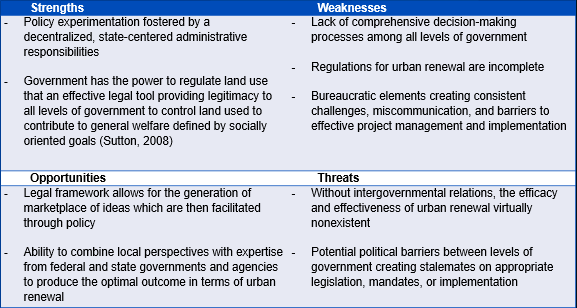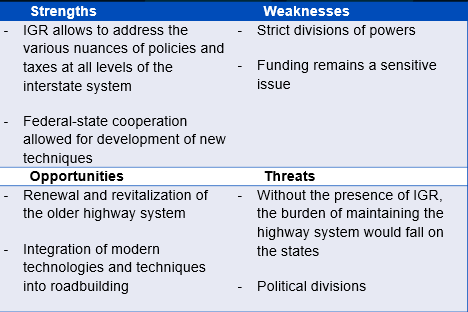Urban Renewal
Urban renewal is a complex series of processes which attempt to revitalize struggling or run-down urban areas via means of land redevelopment, conservation, rehabilitation, or other tools to encourage social and economic growth (Mallach, 2017).
Involves citizens, organizations and agencies at national, state, and local levels. Congress creates legislations and funding for projects. Federal (HUD) and state urban renewal agencies select projects and distribute funds. Local governments participate in choosing projects and overseeing development programs. Citizens and the public are broad terms for any potential stakeholders or investors, those who emphasize the need for change and benefit from urban renewal projects (Ham, 1965).
In the 1970s, there was an expansion of the federal role in urban renewal, forging a direct link between the federal government and cities whereas states were seen as the weak link. However, towards modern day, states have been playing a larger role. It is the critical role of the federal agencies and state government to ensure that everyone benefits from the revitalization. Federal and state officials can play an important role in fostering inter-municipal cooperation and standards by recruiting high skilled professionals in needed areas to fulfill the renewal projects and to train local officials. It is important not to ignore the interrelationship between these various actors and levels of governance and influences that they have on one another. Agencies urge Congress and the executive administrations to adopt regulations, experts, scholars, activities, and other members of the public emphasize the need for change. Reviews bring amendments to legislation and acquire the necessary funding.
Highways
The U.S. highway system is a complex system of roads first instituted in 1956 by Pres. Eisenhower. The interstate system is a significant element of American culture and economy but also represented one of the most significant collaborations as an intergovernmental project. All levels of government fund the development and upkeep of the surface transportation infrastructure (The Pew Charitable Trusts, 2014).
Examples include exchanging of road construction and management between federal, state, county and municipal governments and agencies. Participation in joint construction or maintenance projects via labor, materials, funding or expertise as well construction of complex structures such as bridges on behalf of other jurisdictions that may lack the expertise or resources. Exchange of equipment, traffic control devices, and other transportation related equipment and resources between locales. Collaborating and conducting joint studies and research regarding environmental or social impacts of highway construction (Arizona Counties Highway Manual, 2004).
The extensive network and infrastructure of the national interstate system is a prime example of intergovernmental cooperation that was necessary to develop, build, and maintain such a robust national project. The modern highway system touches almost every part of the country and represents partnerships between national, state, and local governments ranging from fiscal matters to decision-making regarding highway maintenance and upgrades.
Federal and state level governments often have to cooperate on elements of funding as well as revenue such as from vehicle taxes and tolls. Although the role of the federal government in transportation has been unclear since the interstate system was completed in the 1990s, it still plays an important role, particularly in financing. Intergovernmental partnerships are vital to confronting challenges and maintaining a robust interstate system since state and localities should expect funding and regulation from the federal government, while the federal government needs the expertise and knowledge of jurisdictions to understand how policies and procedures may impact them (The Pew Charitable Trusts, 2014).
Urban Renewal SWOT

State and local governments have a better understanding of local issues and context than the federal government. Therefore, they can develop the best policies and projects in urban development to meet the federal mandates which is a major strength to urban renewal. However, a major weakness is that the federal mandates and regulates are incomplete. Foundational guidelines established by the federal government are broad. This serves as both a benefit and opportunity by generating ideas for highly successful projects which is then translated to binding or enabling legislation.
Therefore, the system works in a manner that local efforts operate with a broad legal framework, contributing to it and implementing policies and projects to address urban renewal. By all cases, the system of urban renewal would not exist as it currently is without intergovernmental relations. The system is inherently complex, requiring bureaucracy and input from all levels. Even if the federal government is not involved, state, city, and locale administrations have to be. The program of urban renewal would cease to exist or be virtually ineffective since local actions require funding from upper echelons of government, while federal and state directed mandates require local expertise and input as well as public support.
Highways SWOT

Federal-state cooperation allows to accomplish the feat of such an expansive infrastructure project which has become an instrument of political, social, and market/industrial life which is a major strength. For weaknesses, each level of government maintains powers implied and given unto them by law. This can create conflicts between federal, state, and county governments. Furthermore, there are often disagreements regarding which level provides funding for specific surface transportation projects.
There are opportunities currently to significantly upgrade an aging highway system, by integrating new roadbuilding techniques and technologies. However, it would require significant IGR for efficient and high-quality optimal results. For threats, states lack both the funding and the capabilities to fully oversee it, resulting in the likely gradual deterioration in quality and safety. Finally, political divisions regarding transportation infrastructure projects has been evident since the creation of the highway system but remains a large threat to this day at a time when infrastructure around the country is in dire need of upgrades.
References
- Arizona Counties Highway Manual. (2004). Intergovernmental relations. Web.
- Ham, C. C. (1965). Urban renewal: A case study in emerging goals in an intergovernmental setting. The ANNALS of the American Academy of Political and Social Science, 359(1), 44–52. Web.
- Mallach, A. (2017). State government and urban revitalization: How states can foster stronger, more inclusive cities. Web.
- Sutton, S. A. (2008). Urban revitalization in the United States: Policies and practices. Web.
- The Pew Charitable Trusts. (2014). Intergovernmental challenges in surface transportation funding. Web.
